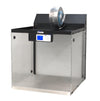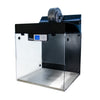Is the Ossila Laminar Flow Hood Sterile?
When working with sensitive samples, you should be confident that a laminar flow hood can maintain a sterile environment. This is especially true during microbiological experiments and preparation, such as growing cell cultures or preparing media plates. You can test if the air flow is sterile using settle plates and if the surfaces are sterile using contact plates.
To check that our laminar flow hood is suitable for microbiological uses, we tested for air and surface contamination. In addition to testing within the hood, we also collected samples on a regular lab bench for comparison.
How to Test Laminar Flow Hood Sterility
We conducted these tests in our horizontal laminar flow hood. Before starting air flow and surface testing, we cleaned the laminar flow hood following our recommended method.



To test the sterility of the air flow inside the Ossila Laminar Flow Hood, we exposed Tryptic Soy Agar Contact (TS3N) plates and Sabouraud Dextrose Agar Contact (SDCL) plates to the internal environment. TS3N plates and SDCL plates will encourage growth of bacterial and fungal colonies, respectively. These plates were exposed for either 7 or 24 hours, before being sealed and incubated at 37°C for 72 hours.
To test how sterile the surface is (after proper cleaning and UV sterilization), we placed TS3N and SDCL plates in direct contact with the tray. These plates were left for 1 hour, before being incubated at 37°C for 72 hours.
For both contact and air flow tests, we made comparison plates on a standard lab bench. This provides a control for how clean the laminar flow hood is compared to a normal laboratory environment.
Horizontal Laminar Flow Hood

- Eco-Friendly
- Fully Equipped
- High Purity Air
Available Now! £2,500
Air Flow Contamination
The results of our air flow tests are contained in the table below.
| Agar Plate | No. of Colonies Outside Laminar Flow Hood (after 7 hours) | No. of Colonies Inside Laminar Flow Hood (after 7 hours) |
| T3SN | 10 | 0 |
| SDCL | 3 | 0 |
After 7 hours, the plate exposed to a normal laboratory environment were quite contaminated. There is evidence of both bacterial and fungal contamination. However, both plates exposed to the laminar flow hood environment were clean and uncontaminated. This proves that the laminar air flow, along with UV sterilization, can sustain a sterile environment for up to 7 hours.


We also tested how long the laminar flow hood can prevent contamination, beyond the inital 7 hours. To do this, we left a plate exposed to the internal air flow in the laminar flow hood for 24 hours.
After 24 hours in the laminar flow hood, no contamination was seen in either plate.


Surface Contamination
The results of our surface contamination tests are contained in the table below.
| Agar Plate | No. of Colonies Outside Laminar Flow Hood (after 1 hour contact) | No. of Colonies Inside Laminar Flow Hood (after 1 hour contact) |
| T3SN | 16 | 0 |
| SDCL | 2 (majority coverage) | 0 |
After 1 hour in contact with a general lab bench, the plates had significant bacterial and fungal growth. However, the plates put in contact with the disinfected and UV sterilized hood tray remained clear after incubation.


Maintaining a Sterile Environment
With filtered laminar air flow and UV sterilization, our laminar flow hood creates an exceptionally sterile workspace. This sterility is maintained for extended periods, up to 24 hours in this instance.
By cleaning with disinfectant and using UV sterilization, the internal surfaces of our laminar flow hood are sterile. Whereas, a general lab bench has significant levels of contamination.
These tests demonstrate the sterility of a laminar flow hood workspace is essential for working with sensitive or biological samples.
Laminar Flow Hoods

- Vertical/Horizontal Models
- Fully Equipped
- High Purity Air
Available Now! £2,500